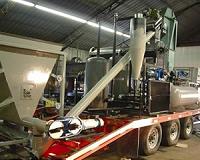 |
West Lafayette IN (SPX) Nov 29, 2010 Purdue University scientists have found the last undiscovered gene responsible for the production of the amino acid phenylalanine, a discovery that could lead to processes to control the amino acid to boost plants' nutritional values and produce better biofuel feedstocks. Natalia Dudareva, a distinguished professor of horticulture, and Hiroshi Maeda, a postdoctoral researcher in Dudareva's laboratory, determined that the gene is one of 10 responsible for phenylalanine production in plants. Understanding how the amino acid is produced could provide a strategy to increase or reduce that production. Phenylalanine is important for plant protein synthesis and for the production of flower scent, anti-oxidants and lignin, a principal plant cell wall component that helps plants stand upright and acts as a barrier in the production of cellulosic ethanol. It is one of the few essential amino acids that humans and animals cannot synthesize, so it must come from plants. "In plant tissues where we want to lower lignin content, we may be able to block these pathways," Maeda said. "In cases where you want to increase the amount of phenylalanine, we could do that as well." Decreasing phenylalanine could lead to a reduction in lignin, which would improve digestibility of cellulosic materials for ethanol production. Increasing phenylalanine could boost the nutritional value of some foods. Dudareva and Maeda used a co-expression analysis to find the prephenate aminotransferase gene. They monitored the expression activity of nine genes in the research plant Arabidopsis that were known to be involved in phenylalanine production and looked for other genes that became active at the same time. "This gene had almost identical gene expression patterns as the known phenylalanine-related genes," Maeda said. The comparable gene in petunias also was identified. Dudareva and Maeda confirmed that its expression patterns matched other genes involved in the formation of phenylalanine and volatile scent compounds in the flower. To test the find, Dudareva and Maeda used the E. coli bacteria. They overexpressed the protein encoded by newly discovered gene and detected the expected enzyme activity. They also decreased the gene's expression in petunia flowers and witnessed a reduction in phenylalanine production. "We provided both biochemical and genetic evidence that the gene is indeed involved in phenylalanine biosynthesis," Dudareva said. "It completes the pathway." Dudareva said she would use the discovery to increase the scent of flowers in order to study the interaction of insects with flowers. Dudareva and Maeda's findings were published in the early online version of the journal Nature Chemical Biology. The National Science Foundation funded the research.
Share This Article With Planet Earth
Related Links Purdue University Bio Fuel Technology and Application News
 A High-Yield Biomass Alternative To Petroleum For Industrial Chemicals
A High-Yield Biomass Alternative To Petroleum For Industrial ChemicalsAmherst MA (SPX) Nov 29, 2010 A team of University of Massachusetts Amherst chemical engineers report in Science that they have developed a way to produce high-volume chemical feedstocks including benzene, toluene, xylenes and olefins from pyrolytic bio-oils, the cheapest liquid fuels available today derived from biomass. The new process could reduce or eliminate industry's reliance on fossil fuels to make industrial chemica ... read more |
|
| The content herein, unless otherwise known to be public domain, are Copyright 1995-2010 - SpaceDaily. AFP and UPI Wire Stories are copyright Agence France-Presse and United Press International. ESA Portal Reports are copyright European Space Agency. All NASA sourced material is public domain. Additional copyrights may apply in whole or part to other bona fide parties. Advertising does not imply endorsement,agreement or approval of any opinions, statements or information provided by SpaceDaily on any Web page published or hosted by SpaceDaily. Privacy Statement |